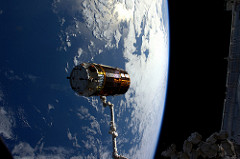Release of HTV6
mardi 31 janvier 2017 à 10:02Thomas Pesquet posted a photo:
We said farewell to the Japanese cargo ship HTV-6 last Friday. Yours truly was at the controls, with Shane Kimbrough monitoring. After 46 days attached to the Space Station we will miss the extra module and space. It is funny to think that the spacecraft is flying alone in space now, before it meets a fiery end as it burns up harmlessly in the atmosphere. Even during its last days it will deliver important information: JAXA is testing a tether they dubbed the Kounotori Integrated Tether Experiment (KITE) – a 700 m long electro-dynamic tether that will drag the spacecraft towards Earth. We need to test this type of technology to ensure future satellites don't stay in orbit around Earth forever but will fall back and disintegrate after they have finished their useful life.
Nous avons donc fait nos adieux au véhicule ravitailleur japonais HTV-6 vendredi dernier. J’étais cette fois-ci aux commandes, épaulé par Shane. Le vaisseau cargo, en plus d’apporter du ravitaillement, a fait office de module supplémentaire pendant les 46 jours qu’il est resté attaché à la Station spatiale. Et maintenant, il flotte seul dans l’espace, avant de brûler sans risque à la rentrée atmosphérique. Une fin... flamboyante ;)
Même en ce moment, l’HTV a un rôle à jouer : l’Agence spatiale japonaise, JAXA, profite du départ de son vaisseau cargo pour tester le « KITE » (Kounotori Integrated Tether Experiment), une attache électrodynamique expérimentale de 700 mètres de long. Son but est de tirer le véhicule en direction de la Terre plus rapidement et avec plus de précision. Ce genre de technologie devrait nous être très utile pour les satellites du futur : on pourra s’assurer qu’ils ne restent pas en orbite autour de la planète une fois devenus obsolètes, mais qu’ils se désintégreront plutôt à la rentrée dans l’atmosphère en retombant sur Terre.
Credits: ESA/NASA
139D3122
